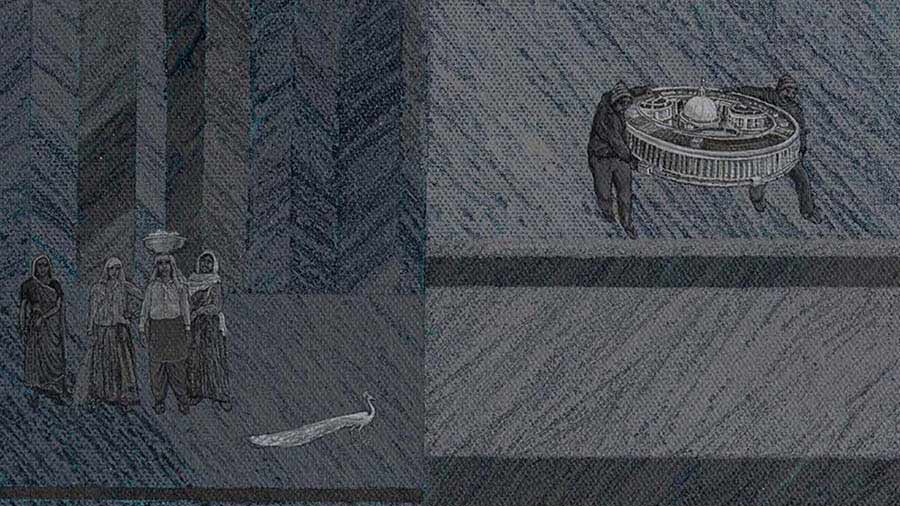“Artists have truly conquered the pandemic.” These words, by the director of CIMA, Rakhi Sarkar, take on new meaning upon walking through the gates of Gem Cinema – one of the two venues where the exhibition of artworks sent in for the CIMA Awards 2022 are being showcased. The Centre of International Modern Art is no stranger to the discovery of artistic excellence, but a sense of the extraordinary becomes immediately evident when one sets foot into the nondescript pathway leading up to the entrance of the old movie house in Central Kolkata.
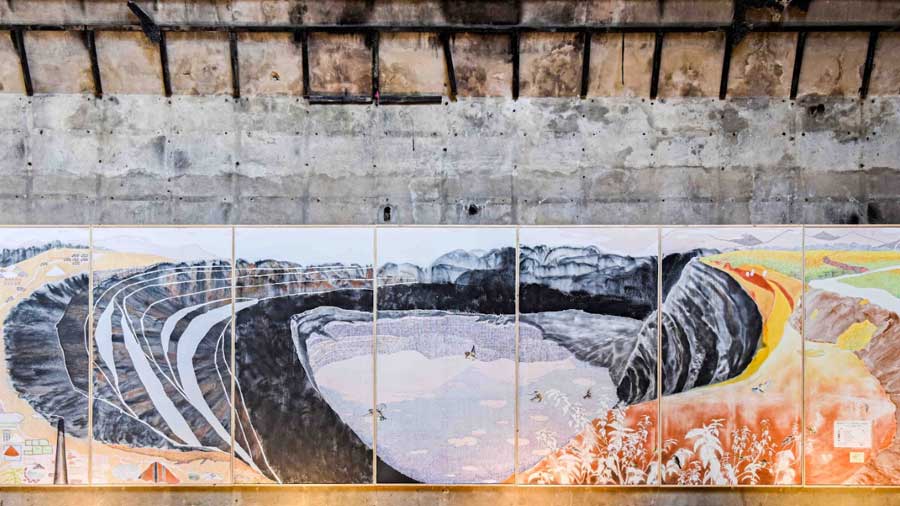
'Black Grave 2' (coal dust, brick dust, charcoal, acrylic, pen and ink on canvas) by CIMA Award winner Suman Chandra, displayed at Gem Cinema Amit Datta
And why should it not? The scope and impact of the triennial CIMA Awards have grown exponentially since the birth of its idea seven years ago. “The awards arose from the need to talk about India and how contemporary artists related to it,” said Sarkar. “In 2015, after 22 years of running CIMA, we felt the need to introspect; were we really serving the needs and prospects of this vast country, with its ancient history, legacy, challenges, exceptional complexities and diversity? Not really. We were merely serving the predilections of an urbanised populace and overlooking the vast reservoir of talent going largely unnoticed in other parts and pockets of the country. It was from this imperative that the idea of CIMA Awards was born.”
The birth of that idea has resulted in the 2022 edition of the CIMA Awards show representing the works of artists across 20 Indian states. More than 180 works of art – paintings, sculptures, graphics, installations, digital and new media art – are displayed across Gem Cinema and CIMA Art Gallery (February 5-27). More importantly, no bar on education and other qualifications was placed on the participants, thereby widening the ambit of the awards to include self-taught artists as well. There is even greater scope for representation – as Sarkar has observed, gender parity remains a challenge, with over 75 per cent of the participants being male – but the opening up of the artistic ambit of the awards constitutes a crucial step towards the highlighting of true creative excellence.
Gem Cinema: Seamless interaction between container and contained
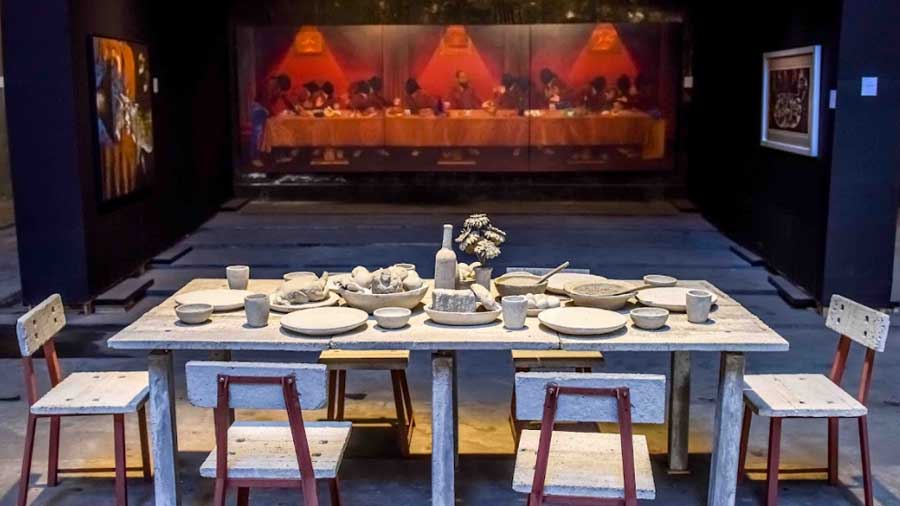
In the foreground, 'Concrete Dinner' (concrete) by CIMA Awards Special Mention winner Sayantan Samanta, displayed at Gem Cinema Amit Datta
The first glimpse of this is evident in the meticulous mounting of the exhibition, particularly at Gem Cinema – the old-world, derelict state of which makes it a remarkable space for housing the nature of the artworks on display. Of particular note is the usage of varied materials by the artists, and the intelligent claiming of the space for arranging the works. Be it Balaram Koley’s hard-hitting Fire in the Belly (jute sacks, jute rope, straw) or Saibal Karmakar’s Collection (etching, antique copper coin and serigraph), viewers are drawn into the immersive experience of the artists’ vision from the moment they enter the driveway of the venue, where these works (and others) are displayed.
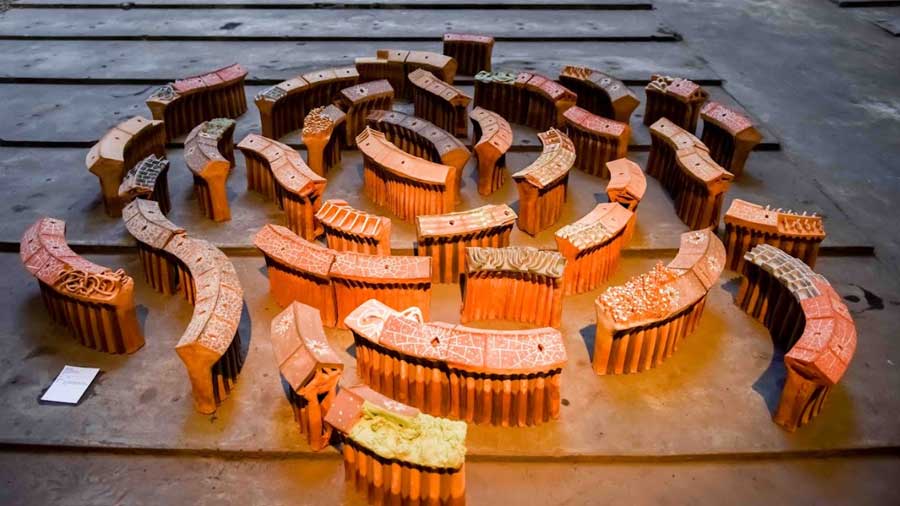
'Structural Anatomy' (applied slip colour on terracotta) by CIMA Awards second runner-up Akshay Maiti, displayed at Gem Cinema Amit Datta
The suffering wrought by the pandemic – particularly in aggravating poverty and exclusion of all sorts – show up as dominant themes in the sculptural works of Kanchan Karjee and Surojit Hazra, both of which the viewer must encounter upon entering different sections of the Gem Cinema building. There is a seamless interaction between the container and the contained – a subject of animated discussion during the recently-concluded CIMA Symposium – as the dilapidated vastness of the venue lends itself to, and mirrors, the effects and messaging of the art it houses. A dark, cavernous room – once a ground-floor screen room – echoes with the strains of Raghupati Raghav Raja Ram as animated images of Mahatma Gandhi at various stages in his life sing along in Asis Kumar Mahakhud’s audio-visual projection Virtual Song. Upstairs, deserted corridors echo the silence and broken desolation of Subhankar Bag’s After Thoughts (wood and coat).
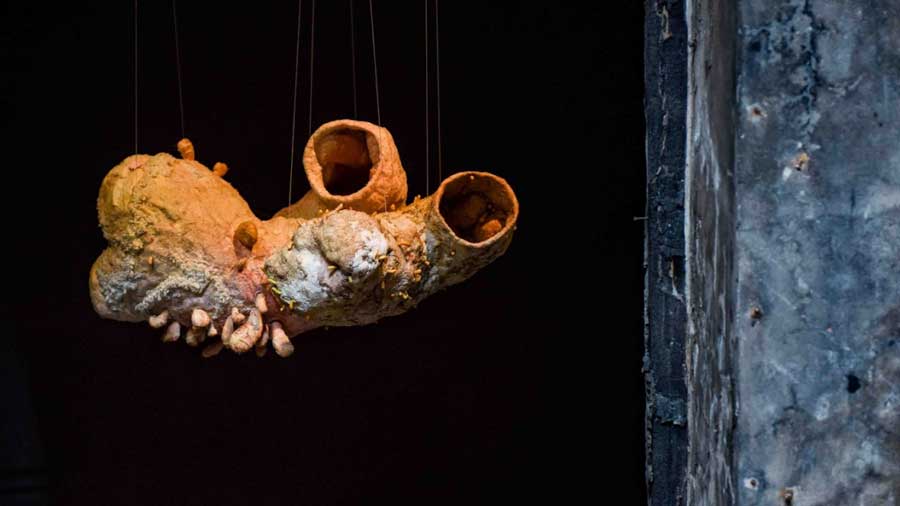
‘Untitled’ (fibre, recycled cotton fabric, synthetic fibre, filter thread, anchor thread, wax, chia seeds, dye and other materials) by director’s choice winner Shivi Yadav, displayed at Gem Cinema Amit Datta
The largest exhibit space on the upper floor houses some of the most remarkable works of the show. They reflect the chaos and darkness of the varied Indian experience, both in their use of material and their tone; several of them went on to win CIMA awards, including Sayantan Samanta’s Concrete Dinner (concrete), second runner-up Akshay Maiti’s Structural Anatomy (applied slip colour on terracotta) and, of course, Black Grave 2 (coal dust, brick dust, charcoal, acrylic, pen and ink on canvas) by the winner, Suman Chandra.
CIMA Gallery: Important disruptions to the sense of serenity
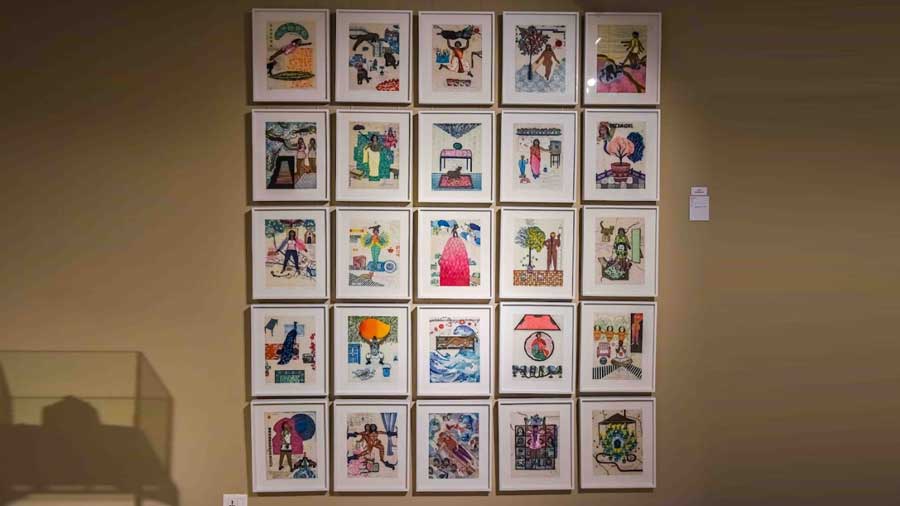
'Kissa Goi' (etching) by CIMA Awards first runner-up Sonal Varshneya, displayed at CIMA Gallery Amit Datta
The transition from the echoing, immersive atmosphere at Gem to the quiet serenity of CIMA Art Gallery feels natural, and is reflected in the curation of the works displayed there. Taking pride of place is first runner-up and print-maker Sonal Varshneya’s Kissa Goi (etching) which, true to its name, tells its viewers stories. And while Saurav Roy Chowdury’s Surrender to Nature (fibreglass, brass, stainless steel wire and deer horn) reflects the shift in atmosphere, works like Sukarna Das’s Mystify (mixed media), Rima Chhari’s Social Distancing (oil and acrylic on canvas) and Joydeep Bhattacharjee’s Que Sara, Sara (digital print on archival paper), among others, provide important disruptions to the sense of serenity, which often tends to morph into apathy in the human experience.

'Surrender to Nature' (fibreglass, brass, stainless steel wire and deer horn) by Saurav Roy Chowdury, displayed at CIMA Gallery Amit Datta

'Que Sara, Sara' (digital print on archival paper) by merit award winner Joydeep Bhattacharjee, displayed at CIMA Gallery Amit Datta
This might be the most important takeaway from a CIMA show that bears the multiplicities of Indian art on so many levels: that art and the spaces it inhabits ask unexpected questions, and, especially in modern times, often give uncomfortable answers.
CIMA Awards show is open from 11am to 7pm everyday till February 27.

